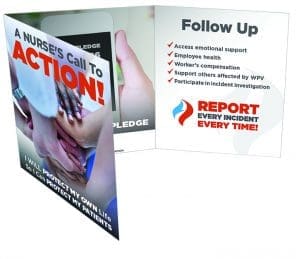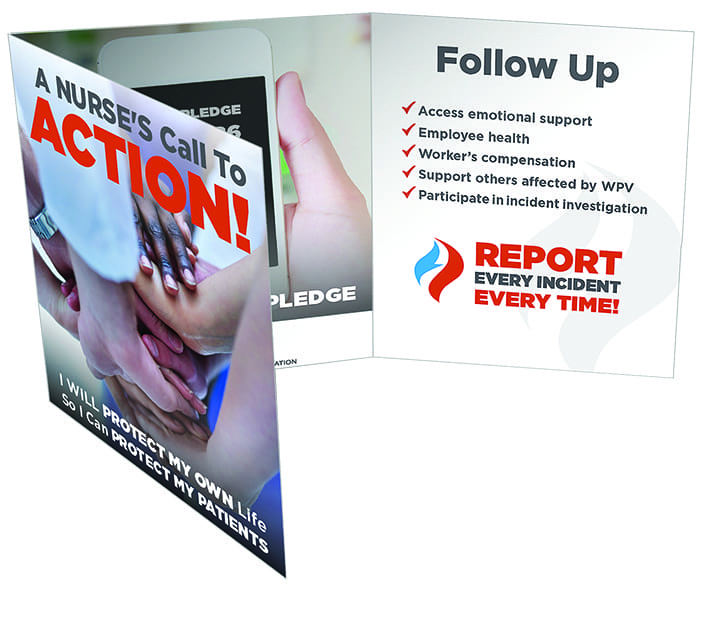New resources to protect RNs from workplace violence
THE American Nurses Association’s (ANA) Health Risk Appraisal in 2016 indicated that 25% of nurses had been physically assaulted by a patient or patient’s family member and 9% were concerned for their personal safety at work. Realizing that nurse assaults continue despite existing policies and programs, ANA brought together a panel of nurse experts to address the issue of workplace violence.
Building on earlier efforts, ANA asked the 2018 #EndNurseAbuse Professional Issues Panel to promote reporting by nurses and other  healthcare workers of incidences of violence and abuse in healthcare; to strengthen zero-tolerance and other violence reduction and security procedures to increase deterrence, support prevention, and increase response to violence and abuse; and to leverage consumers’ voices to advocate for a safer healthcare system.
healthcare workers of incidences of violence and abuse in healthcare; to strengthen zero-tolerance and other violence reduction and security procedures to increase deterrence, support prevention, and increase response to violence and abuse; and to leverage consumers’ voices to advocate for a safer healthcare system.
In 2015, ANA adopted the position statement “Incivility, Bullying, and Workplace Violence.” This statement, developed by a previous professional issues panel, called for zero tolerance of bullying and workplace violence with recommendations for the employer and employee to work together to develop a culture of safety, workplace violence prevention policies, and appropriate action if violence occurs.
Work by both panels resulted in the following resources and opportunities, which are available at the newly launched website, endnurseabuse.org:
Take the pledge. #EndNurseAbuse started as an awareness effort to encourage nurses to pledge to support each other by not allowing abuse in the workplace. This initiative has grown to more than 20,000 nurses and other healthcare workers signing on and sharing their commitment on social media. If you haven’t already, take the pledge at endnurseabuse.org.
Read the issues brief. According to the U.S. Government Accountability Office, only 20% to 60% of nurses report incidents of workplace violence. To fully understand why more don’t report, the 2018 panel completed an issues brief, Reporting Incidents of Workplace Violence, that examines the barriers to reporting, discusses how to create a culture of safety, presents a process for reporting, reminds nurses of the zero-tolerance policy, and provides recommendations to combat workplace violence.
Download the pocket-sized brochure. In addition to the issues brief, the panel also created a pocket-sized brochure reminding nurses about the importance of being safe and protecting themselves from violent incidents, using the acronym STOP WPV (workplace violence). The brochure, which fits into a scrubs pocket or behind a name badge, also provides information on what nurses should do when violence occurs.
All of these resources are available on the new #EndNurseAbuse website and at nursingworld.org. Using the mantra “Support, Educate, Take Action, and Share,” nurses can access the brochure, issues brief, and the pledge on the site. If you would like to promote #EndNurseAbuse in your workplace or develop a campaign, you’ll find infographics, a link to an Occupational Safety and Health Administration site to report incidents, and a link to customize a letter to lawmakers or to contact your legislator.
ANA expresses its appreciation to the 2018 #EndNurseAbuse Professional Issues Panel members for their hard work.
Take action! Federal legislation
ANA supports the Workplace Violence Prevention for Health Care and Social Service Workers Act (H.R. 1309 and S. 851), which asks for a national collection and reporting system as the first step toward advancing workplace violence research. Visit RNAction.org for more information and how you can support the bill.
Ruth Francis is senior policy advisor in the Nursing Practice & Work Environment Department at ANA.
Selected references
American Nurses Association & Insight Consulting Group. 2016. Health risk appraisal exploratory data analysis: November 30, 2016.
U.S. Government Accountability Office. Workplace Safety and Health: Additional Efforts Needed to Help Protect Health Care Workers from Workplace Violence. March 2016. gao.gov/assets/680/675858.pdf



















1 Comment.
Nurses suffer a lot of physical, mental and emotional abuse and most nurses take it as part of the job which should not be so. This problem has resulted to a lot of nurses leaving nursing and venturing into other professions. It is also one of the reasons nursing shortage is constantly on the rise. A study released earlier this year shed light on an alarming finding suicide rate among nurses. Suicide incidence was 11.97 per 100,000 person-years among female nurses and 39.8 per 100,000 among male nurses (Yazdi, 2017).
I remember the previous hospital I worked enforced the American Nurse Association (ANA) position statement “Incivility, Bullying, and Workplace Violence” and zero tolerance of bullying and workplace violence (Francis, 2019). However, this current hospital condones nursing abuse. The mental and emotional abuse seems to come from the managers and supervisors. I am glad and encouraged to know that the American Nurses association is creating awareness to this issue however, nurses will have to stand up for themselves by coming together develop and enforce a culture of safety in the workplace, policies that support workplace violence prevention and an appropriate action if violence occurs.